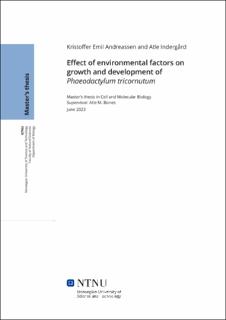| dc.description.abstract | Diatoms are eukaryotic photosynthetic organisms found in marine and freshwater environments as primary producers accounting for ~20% of total world photosynthetic output and ~50% of oceanic biomass. Diatoms are of industrial interest as they are lipid accumulating, which could be used in the production of animal feed or biofuels without occupying agricultural space. An important model diatom is P. tricornutum which is a resilient, fast-growing organism. Our knowledge of diatoms is not proportional to their importance and lags behind that of plants and green algae. It is important to better understand them so that we might predict how they will adapt to a changing world climate.
Through this thesis we have looked at how three environmental factors, salinity, pH and presence of herbicides (glyphosate derived from roundup) impact the growth of P. tricornutum. Salinity treated cells were RNA sequenced, underwent lipid extraction with fatty acid analysis. Our findings indicate that high salinity led to a decrease in growth rate, in contrast to low salinity conditions which led to an increase in growth rate. Analysis of fatty acid composition showed that the low salinity treatment had a higher percentage of polyunsaturated fatty acids (PUFAs) with high salinity treatment showing the opposite response. RNA sequencing showed many genes to be differentially expressed, several of which were associated with sodium and chloride. However, a large portion of the differentially expressed genes coded for proteins of unknown function.
The pH treatments showed a decrease in P. tricornutum growth as the pH decreased from normal (pH 8.1), with growth ceasing entirely at pH 5.1. Cell death staining using propidium iodide was performed on the glyphosate treatments. From the glyphosate treatments we saw rapid cell death staining at the highest concentrations (0.8 and 0.4 g/L) while the lower concentration treatments showed a slowly increasing cell death stain percentage, reaching ~20% following 96 hours.
In conclusion, our results show that alterations in environmental conditions can dramatically impact the growth of P. tricornutum depending on the degree of environmental change. Additionally, we saw several opportunities to further develop the knowledge of P. tricornutum and diatoms in general. | |
